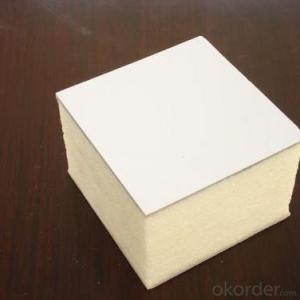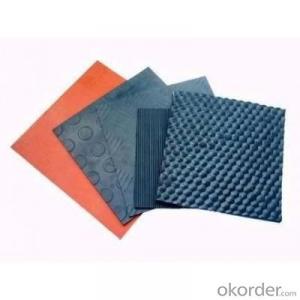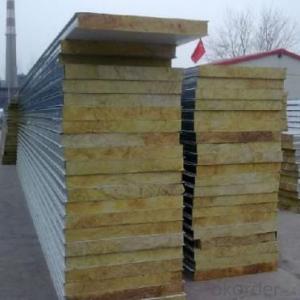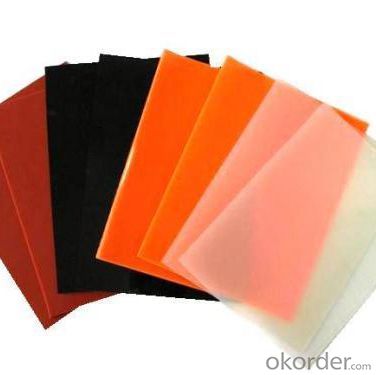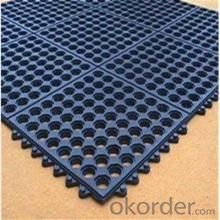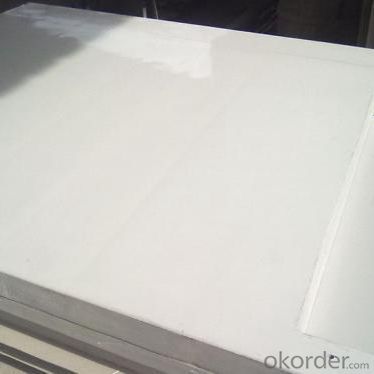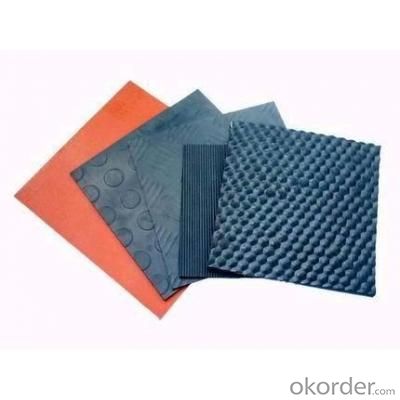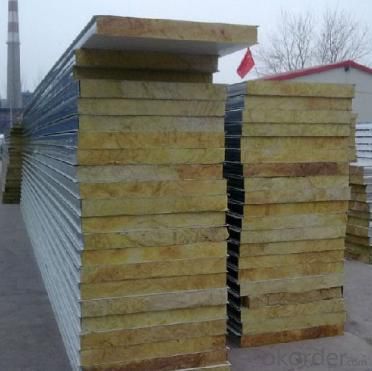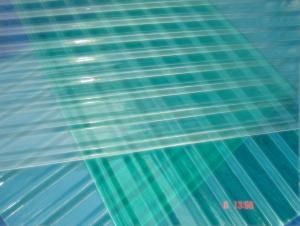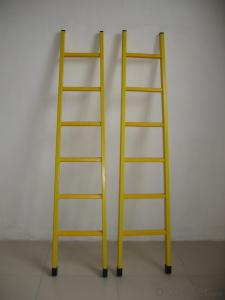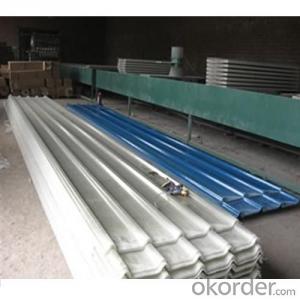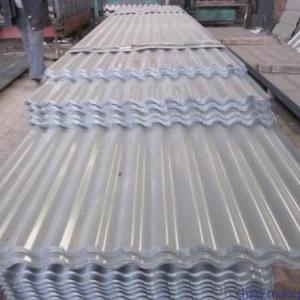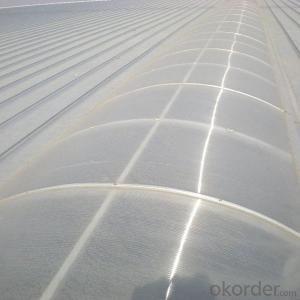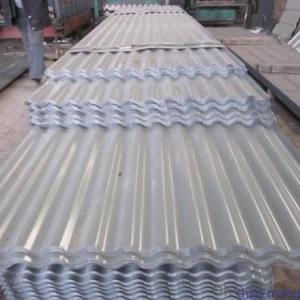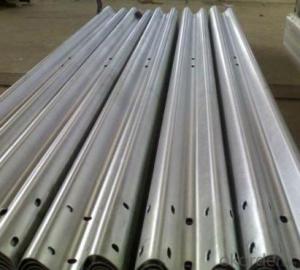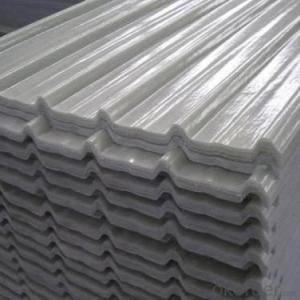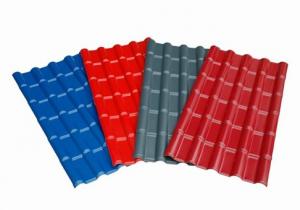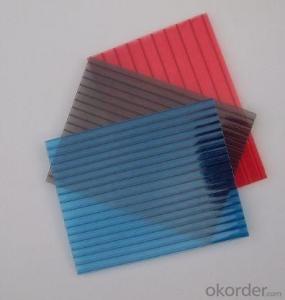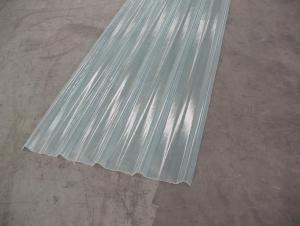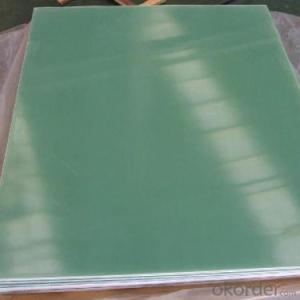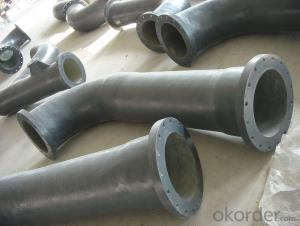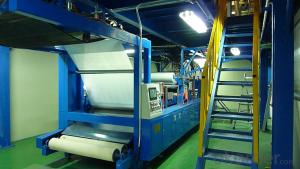Frp Translucent Fiberglass Roofing Sheets
- Loading Port:
- Tianjin
- Payment Terms:
- TT OR LC
- Min Order Qty:
- 300 m
- Supply Capability:
- 50000 m/month
OKorder Service Pledge
OKorder Financial Service
You Might Also Like
Specification
PRODUCT DESCRIPTION
Corrugated Roofing Sheets usually use a protecting facility in construction site,steel structured workshop and warehouse,canopy,packing sheds,corridors,studio light awning and greenhouse etc as the excellent light transmittance.FRP plane skylight is the more strengthened, safety, and more econimal greenhouse panel with the properties of waterproof,good light transmittance,heat insulation,strong impact resistant, withstand extreme temperature.
FEATURES
1.Light transmission
The light transmission of FRP roof Sheet is between 60-85%. Light through FRP corrugated Sheet scatters and is
mild. It will not form a light band so as to make the indoor brighter.
2.Weather resistance
The anti-aging film covering on the surface of FRP corrugated sheet improves its property of weather resistance.
The anti- ultraviolet adsorbing agent mixing in the raw materials absorbs 99.9% of ultraviolet ray of the visible
light transmitted through the FRP sheets.
3.Corrosion resistance
The products resist various acids, alkalis and peroxides, especially suitable for application in the coastal areas and
corrosive places.Temperature performance and insulation FRP roof Sheet is a kind of hot solid high
polymer materials. It is designed for normal use in temperatures - 40℃~120℃ .The coefficient of heat conduction of
FRP roof Sheet is only 1/4 of the glass.
SPECIFICATIONS
| Name: | Fibreglass Reinforced Polyester(FRP ) Sheet |
| Material: | Protective film, Unsaturated resin polyester, Fiberglass |
| Weight: | 1800g/2400g/2750g/3050g Square meter |
| Thickness: | 0.8~3.0mm |
| Length: | Customized |
| Temp: | used in -40°c to 140 °c |
| OEM: | Welcomed |
| Color: | Clear/Blue |
PICTURES

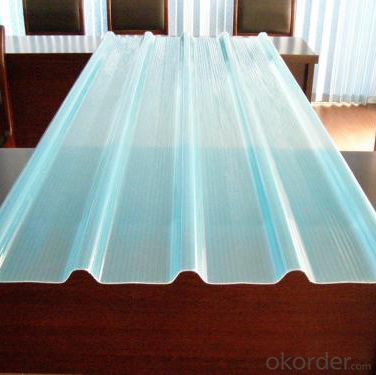

- Q: Are FRP roofing panels resistant to impact damage from falling debris?
- Yes, FRP (Fiberglass Reinforced Plastic) roofing panels are generally resistant to impact damage from falling debris. FRP panels are manufactured using a combination of fiberglass and plastic resin, which makes them strong and durable. They are designed to withstand various weather conditions and are known for their impact resistance. This makes them suitable for areas where there is a risk of falling debris, such as in industrial or construction sites. However, it is important to note that the level of impact resistance can vary depending on the specific brand and quality of the FRP roofing panels. It is always recommended to consult with the manufacturer or a roofing professional to ensure that the chosen FRP panels are suitable for the specific application and expected impact loads.
- Q: How do FRP roofing panels compare to traditional roofing materials in terms of durability?
- FRP (Fiberglass Reinforced Plastic) roofing panels are known for their exceptional durability, making them a reliable alternative to traditional roofing materials. When compared to traditional materials like asphalt shingles or metal roofing, FRP panels offer several advantages in terms of durability. Firstly, FRP roofing panels are highly resistant to weather elements such as rain, snow, hail, and UV rays. The fiberglass reinforcement provides strength and prevents cracking or warping in extreme weather conditions. This durability allows FRP panels to maintain their structural integrity over time, providing long-lasting protection for a building. Moreover, FRP panels are resistant to corrosion and chemical damage, which is particularly beneficial in areas with high humidity or exposure to chemicals. Unlike metal roofing, which may rust or corrode over time, FRP panels retain their original strength and appearance. Another advantage of FRP roofing panels is their resistance to fire. Unlike traditional materials like wood or asphalt, which are highly flammable, FRP panels have excellent fire resistance properties. They are self-extinguishing and do not contribute to the spread of fire, making them a safer option for roofing. Furthermore, FRP panels are lightweight yet strong, making them easier to handle and install. Their lightweight nature reduces the strain on the building's structure while providing excellent durability. This can be particularly advantageous for large-scale roofing projects or when replacing existing roofs. In summary, FRP roofing panels offer superior durability compared to traditional roofing materials. Their resistance to weather elements, corrosion, chemicals, and fire make them a reliable choice for long-lasting protection. Additionally, their lightweight nature and ease of installation add to their appeal.
- Q: Do FRP roofing panels require any specific tools for installation?
- Indeed, specific tools are necessary for the installation of FRP (Fiberglass Reinforced Plastic) roofing panels. Several commonly required tools encompass a power drill equipped with suitable drill bits, a saw to cut the panels to appropriate dimensions, a tape measure, a level to guarantee precise alignment, a caulking gun for sealant application, screws or nails to securely fasten the panels, and a ladder or scaffolding to access the roof. It is crucial to employ the appropriate tools to guarantee a meticulous and steadfast installation of FRP roofing panels.
- Q: Can FRP roofing panels be installed over shingles?
- In certain circumstances, it is indeed possible to install FRP (Fiberglass Reinforced Plastic) roofing panels over shingles. However, there are several factors that need to be taken into account before proceeding with this installation method. First and foremost, it is crucial to evaluate the condition of the current shingles. If they are damaged, deteriorated, or not level, it is advisable to remove them prior to installing the FRP roofing panels. This will ensure a smooth and stable surface for the panels to be securely attached to. In addition, the weight of the FRP panels should be considered. The additional weight may surpass the load-bearing capacity of the roof structure, particularly if multiple layers of shingles are already present. Seeking the advice of a structural engineer or a professional roofing contractor is recommended to assess the roof's capacity and determine if any reinforcements are necessary. Furthermore, it is essential to adhere to proper installation techniques in order to achieve a secure and watertight seal. The panels should be fastened with appropriate fasteners like screws or nails, into the underlying roof structure. It is crucial to follow the installation guidelines and recommendations provided by the manufacturer to avoid any potential problems. Lastly, it should be noted that installing FRP roofing panels over shingles may impact the warranties of both the shingles and the FRP panels. It is advisable to carefully review the warranty documents provided by the manufacturers to understand any potential consequences. To summarize, while it is possible to install FRP roofing panels over shingles, it is vital to consider the condition of the current shingles, the weight limitations of the roof structure, and to adhere to proper installation techniques. Consulting with professionals and reviewing warranty information is highly recommended to ensure a successful and long-lasting installation.
- Q: Can FRP roofing panels be installed on both residential and commercial covered walkways?
- Yes, FRP roofing panels can be installed on both residential and commercial covered walkways. FRP (Fiberglass Reinforced Plastic) roofing panels are versatile and durable, making them suitable for various applications, including covered walkways. Whether it is a residential or commercial setting, FRP roofing panels offer excellent weather resistance and can provide a long-lasting and aesthetically pleasing solution for covered walkways.
- Q: Are FRP roofing panels resistant to chemical exposure from nearby industries?
- Yes, FRP roofing panels are generally resistant to chemical exposure from nearby industries. FRP (Fiberglass Reinforced Plastic) is known for its excellent chemical resistance properties, making it a suitable choice for environments with potential chemical exposure. However, it is important to consider the specific chemicals involved and consult with the manufacturer or an expert to ensure the panels are compatible with the specific chemicals present in the nearby industries.
- Q: Can FRP roofing panels be used in commercial buildings?
- FRP roofing panels have the ability to be utilized in commercial buildings. Their durability, strength, and resistance to different environmental elements make them a favored choice for these types of structures. Despite being lightweight, they offer superb protection against UV rays, extreme temperatures, and corrosion. Moreover, FRP panels are simple to install, require minimal upkeep, and can be tailored to fit specific design needs. Their cost-effectiveness also makes them a sensible choice for owners of commercial buildings. In conclusion, FRP roofing panels are a viable option for commercial buildings, offering enduring and dependable roofing solutions.
- Q: Can FRP roofing panels be used for pergolas?
- Certainly! Pergolas can indeed incorporate FRP (Fiberglass Reinforced Plastic) roofing panels. These panels possess remarkable qualities such as durability, lightness, and corrosion resistance, rendering them an exceptional option for outdoor structures like pergolas. By shielding against the elements, they enable the pleasant passage of natural light, thereby establishing an inviting and cozy open-air atmosphere. Furthermore, the simplicity of installation and maintenance associated with FRP panels makes them a highly pragmatic selection for pergolas.
- Q: Are FRP roofing panels resistant to staining or discoloration from environmental factors?
- Yes, FRP roofing panels are highly resistant to staining or discoloration caused by environmental factors.
- Q: What is the average lifespan of the gel coat on FRP roofing panels?
- The average lifespan of the gel coat on FRP (Fiberglass Reinforced Plastic) roofing panels can vary depending on various factors such as the quality of the gel coat, the installation process, and the environmental conditions it is exposed to. However, on average, a well-maintained and properly installed gel coat can last anywhere from 15 to 30 years. Regular inspection, cleaning, and maintenance can help extend the lifespan of the gel coat, ensuring better protection and longevity for FRP roofing panels.
Send your message to us
Frp Translucent Fiberglass Roofing Sheets
- Loading Port:
- Tianjin
- Payment Terms:
- TT OR LC
- Min Order Qty:
- 300 m
- Supply Capability:
- 50000 m/month
OKorder Service Pledge
OKorder Financial Service
Similar products
Hot products
Hot Searches
Related keywords
